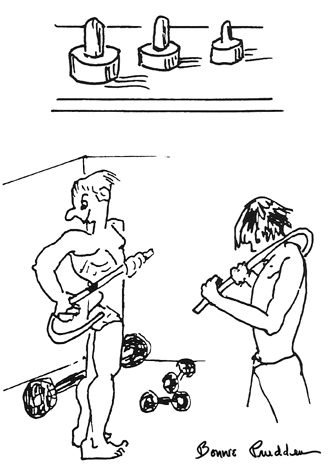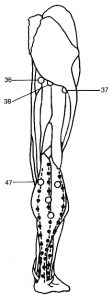The Knees Go First
It is often said that the knees go first when it comes to athletes. And we hear of football greats like Joe Namath who have undergone knee replacements at the young age of 48 and go on to sell products like Icy Hot or supplements for joints. For the most part knees work perfectly well unless they are abused and misused by constant blows as with the football player, overloaded as with weightlifting, or enduring the repetitive pounding experienced by the knee of the runner on the road.
There was a time when youngsters were not allowed to do deep knee bends. It seems that a study was done using 5 football players and weight lifters who were asked to do “duck walks” and then complained that their knees hurt. The conclusion of the study was that duck walks and knee bends were bad. The net result of that totally mistaken paper was that children in elementary schools were told that knee bends were dangerous.
Most football players are damaged in High School. By the time they get to a college field they have already sustained injuries that will haunt them for the rest of their lives. Knees are not only over worked, they are often undertrained and this goes especially for youngsters who begin their weight training too early with too much weight.
Knees – like the rest of the body – need to be used, and we in America have largely eliminated the natural way of developing knees: walking, climbing and bending. The knee is controlled, for the most part, by the quadriceps in the front of the upper leg and the gastroc in the back of the lower leg. The lower leg and feet propel you up the stairs, the quadriceps are used to come down. And if you are a mountain climber or serious hiker you KNOW what your quadriceps can feel like at the end of your day.
Reclaiming Your Knees With Bonnie Prudden Myotherapy®
Bonnie Prudden Myotherapy® erases muscle pain, increases flexibility and improves function. The discipline involves finding and treating trigger points: irritable spots in the muscle, which get there when the muscle in injured in some way. We gather trigger points throughout our lives and in a number of ways: birth, accidents, sports, occupations, hobbies, operations and disease.
Accidents and sports are just two ways to collect trigger points.
Old injuries are like a weak link. Once the trigger points are in the injured muscle, they wait around for you to make a wrong move or add extra stress to your life. Then they respond by throwing the muscle into spasm. Left untreated, the spasms become a spasm-pain-spasm cycle… or chronic pain. Re-educating the muscle with corrective exercises is designed to remind the muscle that it has to learn a new habit in order to remain pain free.
In each of Bonnie Prudden’s books, (the best known are Pain Erasure The Bonnie Prudden Way, Myotherapy, Bonnie Pruddden’s Complete Guide To Pain Free Living and Bonnie Prudden’s After Fifty Fitness Guide), Bonnie maps out exactly how to locate your trigger points, treat them, and prevent the return of the problem. These books are available on our website store www.bpruddencom.wwwaz1-tr101.supercp.com.
 Test First
Test First
To determine why your knees hurt and where the problem lies, you need to test the muscles that are most likely to cause the pain or stiffness: the quadriceps and the calf muscles. The easiest way to test the quadriceps is to lie face down, bend your knee and have someone press your ankle toward your back pocket. Your heel should touch your back  pocket area or gluteals. If your heel doesn’t touch, measure the distance from your heel to your gluteals. Repeat with the other side. In all my years of treating patients with Bonnie Prudden Myotherapy I have only met one person whose heel actually “flopped” to the seat without pushing. He was a semi-professional soccer player.
pocket area or gluteals. If your heel doesn’t touch, measure the distance from your heel to your gluteals. Repeat with the other side. In all my years of treating patients with Bonnie Prudden Myotherapy I have only met one person whose heel actually “flopped” to the seat without pushing. He was a semi-professional soccer player.
To test the calf muscles, stand barefoot facing a wall with one foot about 2 inches in front of the wall. Bend the knee and keep your foot flat on the floor. Does your knee touch the wall? If so, move it back a bit and retest. Enter the distance from your toes to the wall at the last point where you can successfully bend and touch the wall with your knee while the heel stays flat. Test the other leg. The legs are tested separately because often one set of calf muscles is tighter than the other. The average is 4 inches. Athletes like skiers and dancers require extra flexibility in this area if they are to perform well and not tear the Achilles tendon.
 Finding Your Trigger Points
Finding Your Trigger Points
If you have never experienced what a trigger point feels like, place your left arm (palm down) on a table in front of you. Make a fist with your right hand and extend the middle knuckle. Bring your knuckle down onto the top of your arm at a point just below the bend in your elbow. Press in slowly. In all probability you will feel some discomfort. Most everyone has a trigger point there because we all use our arms a lot. When you find the spot hold the pressure for 7 seconds. The “hurt” should be in the range of 5 / 6 / 7 on a scale of 1 to 10. You want to feel some discomfort but not excruciating pain. Most people describe it as a “good hurt”.
 After you have treated the trigger point you must reeducate the muscle by stretching it with what Bonnie Prudden calls corrective exercise. Extend your arm straight forward, imagining that there is a doorknob just beyond your reach. Reach forward and turn the knob clockwise as far as you can. Then rotate it counter-clockwise. Repeat 4 times to a slow rhythm.
After you have treated the trigger point you must reeducate the muscle by stretching it with what Bonnie Prudden calls corrective exercise. Extend your arm straight forward, imagining that there is a doorknob just beyond your reach. Reach forward and turn the knob clockwise as far as you can. Then rotate it counter-clockwise. Repeat 4 times to a slow rhythm.
 Basically, that is Bonnie Prudden Myotherapy®. SEARCH for the trigger point based on your muscle history, SQUASH the trigger point for 5 to 7 seconds using your knuckle, finger or elbow, then STRETCH the muscle area just treated to teach it a new habit and prevent the pain from returning.
Basically, that is Bonnie Prudden Myotherapy®. SEARCH for the trigger point based on your muscle history, SQUASH the trigger point for 5 to 7 seconds using your knuckle, finger or elbow, then STRETCH the muscle area just treated to teach it a new habit and prevent the pain from returning.
Self Help Tools
Bonnie Prudden Myotherapy® can be done with a partner or by yourself. All you need are the Self Help tools. To find these and see how to use them, go to our website – www.bpruddencom.wwwaz1-tr101.supercp.com – and click on the appropriate videos. The videos will also show you how to work on your partner.
 Trigger Points In The Quadriceps
Trigger Points In The Quadriceps
Using the illustration of the anterior leg as your guide, follow the dotted lines as outlined. Note that the elbow is cupped between the thumb and forefinger to prevent slipping. Also note that the elbow is directly under the shoulder – which means that you will be on the point of your elbow and therefore be more exact and can use the weight of your own body to do the work.  Follow the dotted lines holding each sensitive point for 7 seconds before moving on. Go in slowly and listen to the body under your hands.
Follow the dotted lines holding each sensitive point for 7 seconds before moving on. Go in slowly and listen to the body under your hands.
To treat the outside line, reach over the body. To treat the inside line, walk around to the other side for the best angle and control.
 Trigger Points In The Calf Muscles
Trigger Points In The Calf Muscles
To treat the trigger points in the calf muscles have your partner lie face down. Using the same technique, follow the three dotted lines in the calf muscles (middle, inside and outside) as shown in the diagram of the posterior leg. If you pretend that the lower leg is covered with nylons of the olden days (with a seam down the middle), you will know exactly where to go. These can be very sensitive so make sure your partner does not react by bending the other leg and kicking you in the head. Go in slowly. Remember YOU may be the next person on the table.
Re-educating the Muscle With Corrective Exercise
Following the treatment stand up, with feet together, and do half knee bends to a rhythm: down two, up, two. Down, two, up two. Repeat 4 times keeping your feet flat. Do not let your heels come up. For best results, repeat this exercise often throughout the day as a reminder to your newly freed muscles.
How to your knees feel? Less painful, safer, more alive?
Retesting
To see how good your treatment was and to encourage your hurting person, use the two tests at the beginning and test yourself again. In both cases you will probably find your muscles are looser and happier and that your measurements have improved.
More Work To Be Done
Like many things in life, it often takes time to get there. In this case it is likely that you will need more than one trigger point Myotherapy treatment to reap the full benefits. This is the beginning step.
For complete information and directions on how to treat yourself and others with Bonnie Prudden Myotherapy see the books Pain Erasure the Bonnie Prudden Way, Myotherapy, Bonnie Prudden’s Complete Guide To Pain Free Living or Bonnie Prudden’s After Fifty Fitness Guide.
We are always happy to help you feel better!
——————————————————-
For more information about Bonnie Prudden®, Bonnie Prudden Myotherapy®, workshops, books, self-help tools, DVDs, educational videos, and blogs, visit www.bpruddencom.wwwaz1-tr101.supercp.com. Or call 520-299-8064 if you have questions or need help.
Enid Whittaker, Managing Director, Bonnie Prudden Myotherapy
